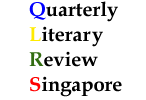 |
 |
|||||||||||||
|
Very Short. Too Short. Just Short Enough.
By Tan Cheng Hung
I ask my students, "Is this a story?"
Their raised hands stab the air and the debate starts quickly. How can this be a story? It's an idea for a story. It's a summary, not the real story. There is no conclusion. Is this a joke? No, definitely not a story. I have taught this flash fiction lesson a number of times and I am always surprised at how indignant my students become. Some of them sound personally affronted by these two sentences. This entire class of sixteen teenagers all agree this is not a story and how dare it pass itself off as a story! "If this is not a story, what do you expect in a story? What will satisfy you as a reader and writer?" I ask. "Conflict." Very short, too short, just short enough is the lifespan of a piece of flash fiction. It is a story with gaps for the reader to fill in. I love writing flash fiction because both the writer and reader interact with the story. The nature of this concise form means the writer offers a textual snapshot to the reader to suggest what comes before and after. I enjoy teaching flash fiction because just when my students think they know what a short story is, along comes this little upstart to challenge what a story can be. It is the Goldilocks theory of story writing: too much, not enough, just right. The flash fictionist has to be much more discerning to make every word count in a tight space. A short story writer has more space to flex and a novelist can meander. How do you find the balance? Slowly and surely, we all come to a place where my students see how to do this. They trust me and will go along with the weirdness I ask them to try. I've created an activity to write a piece of flash fiction in six sentences. No multiple commas and clauses. Two sentences each for the beginning, middle and end. A different person will write each section but I don't tell them this. I am an actor and I understand the importance of timing and suspense. After they write the first two sentences, I walk around to collect the papers and now they know what is next. The buzz in the room increases when I randomly give each of them a piece of paper. Silence settles when the writer brain kicks in and they have ten minutes to write the middle of the story. I have another surprise. I want them to choose who will write the final two sentences. They walk around the room to entrust the story to a friend. Anytime I can get a writer to get up and move is a good thing. We settle into our writing place and can stay there for a very long time while we grapple with our stories. Another ten minutes to end the story. Everyone writes, smiles, frowns, holds their head, freezes and writes again. There is a silence that falls over a room when a writer is working. There is a special silence when a whole room of writers are focused on the same thing. They take turns to read out their first piece of flash fiction. What surprises them are the unexpected juxtapositions, or when one writer continues seamlessly in the same style as the previous writer, or when abrupt shifts in style and tone mostly work and most of all, the many ways flash fiction can end. The ending of a piece of flash fiction deserves its own micro-essay. The beauty of an open-ended resolution. The mystery of the suspended resolution. The hint of what is next as each reader can fill in the blank and take the story in whatever direction they choose. I ask them to write their own flash fiction piece. Any topic. No more than four hundred words. This is the number we agree on. I involve my students in making decisions as often as possible. In a school day where they are told over and over what to do and what they cannot do, I give them options to choose whenever I can. Very short, too short, just short enough sums up the flash fiction writing process. The form's brevity is a creative constraint which brings everything into a sharper focus. Make every word count. The diction telescopes and takes on a poetic beauty and austerity. The final story is the essence of the story. A spare portrait where the writer cannot hide. QLRS Vol. 24 No. 3 Jul 2025_____
|
|
|||||||||||||
Copyright © 2001-2025 The Authors
Privacy Policy | Terms of Use |
E-mail